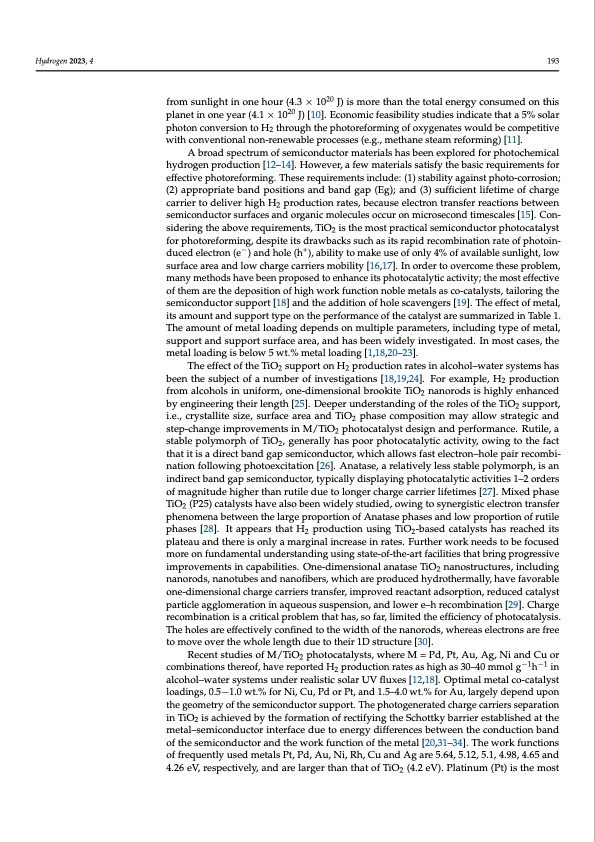
PDF Publication Title:
Text from PDF Page: 002
Hydrogen 2023, 4 193 from sunlight in one hour (4.3 × 1020 J) is more than the total energy consumed on this planet in one year (4.1 × 1020 J) [10]. Economic feasibility studies indicate that a 5% solar photon conversion to H2 through the photoreforming of oxygenates would be competitive with conventional non-renewable processes (e.g., methane steam reforming) [11]. A broad spectrum of semiconductor materials has been explored for photochemical hydrogen production [12–14]. However, a few materials satisfy the basic requirements for effective photoreforming. These requirements include: (1) stability against photo-corrosion; (2) appropriate band positions and band gap (Eg); and (3) sufficient lifetime of charge carrier to deliver high H2 production rates, because electron transfer reactions between semiconductor surfaces and organic molecules occur on microsecond timescales [15]. Con- sidering the above requirements, TiO2 is the most practical semiconductor photocatalyst for photoreforming, despite its drawbacks such as its rapid recombination rate of photoin- duced electron (e−) and hole (h+), ability to make use of only 4% of available sunlight, low surface area and low charge carriers mobility [16,17]. In order to overcome these problem, many methods have been proposed to enhance its photocatalytic activity; the most effective of them are the deposition of high work function noble metals as co-catalysts, tailoring the semiconductor support [18] and the addition of hole scavengers [19]. The effect of metal, its amount and support type on the performance of the catalyst are summarized in Table 1. The amount of metal loading depends on multiple parameters, including type of metal, support and support surface area, and has been widely investigated. In most cases, the metal loading is below 5 wt.% metal loading [1,18,20–23]. The effect of the TiO2 support on H2 production rates in alcohol–water systems has been the subject of a number of investigations [18,19,24]. For example, H2 production from alcohols in uniform, one-dimensional brookite TiO2 nanorods is highly enhanced by engineering their length [25]. Deeper understanding of the roles of the TiO2 support, i.e., crystallite size, surface area and TiO2 phase composition may allow strategic and step-change improvements in M/TiO2 photocatalyst design and performance. Rutile, a stable polymorph of TiO2, generally has poor photocatalytic activity, owing to the fact that it is a direct band gap semiconductor, which allows fast electron–hole pair recombi- nation following photoexcitation [26]. Anatase, a relatively less stable polymorph, is an indirect band gap semiconductor, typically displaying photocatalytic activities 1–2 orders of magnitude higher than rutile due to longer charge carrier lifetimes [27]. Mixed phase TiO2 (P25) catalysts have also been widely studied, owing to synergistic electron transfer phenomena between the large proportion of Anatase phases and low proportion of rutile phases [28]. It appears that H2 production using TiO2-based catalysts has reached its plateau and there is only a marginal increase in rates. Further work needs to be focused more on fundamental understanding using state-of-the-art facilities that bring progressive improvements in capabilities. One-dimensional anatase TiO2 nanostructures, including nanorods, nanotubes and nanofibers, which are produced hydrothermally, have favorable one-dimensional charge carriers transfer, improved reactant adsorption, reduced catalyst particle agglomeration in aqueous suspension, and lower e–h recombination [29]. Charge recombination is a critical problem that has, so far, limited the efficiency of photocatalysis. The holes are effectively confined to the width of the nanorods, whereas electrons are free to move over the whole length due to their 1D structure [30]. Recent studies of M/TiO2 photocatalysts, where M = Pd, Pt, Au, Ag, Ni and Cu or combinations thereof, have reported H2 production rates as high as 30–40 mmol g−1h−1 in alcohol–water systems under realistic solar UV fluxes [12,18]. Optimal metal co-catalyst loadings, 0.5−1.0 wt.% for Ni, Cu, Pd or Pt, and 1.5–4.0 wt.% for Au, largely depend upon the geometry of the semiconductor support. The photogenerated charge carriers separation in TiO2 is achieved by the formation of rectifying the Schottky barrier established at the metal–semiconductor interface due to energy differences between the conduction band of the semiconductor and the work function of the metal [20,31–34]. The work functions of frequently used metals Pt, Pd, Au, Ni, Rh, Cu and Ag are 5.64, 5.12, 5.1, 4.98, 4.65 and 4.26 eV, respectively, and are larger than that of TiO2 (4.2 eV). Platinum (Pt) is the mostPDF Image | Enhanced Photoreforming of Oxygenates

PDF Search Title:
Enhanced Photoreforming of OxygenatesOriginal File Name Searched:
hydrogen-04-00014-v2.pdfDIY PDF Search: Google It | Yahoo | Bing
Salgenx Redox Flow Battery Technology: Power up your energy storage game with Salgenx Salt Water Battery. With its advanced technology, the flow battery provides reliable, scalable, and sustainable energy storage for utility-scale projects. Upgrade to a Salgenx flow battery today and take control of your energy future.
| CONTACT TEL: 608-238-6001 Email: greg@infinityturbine.com | RSS | AMP |